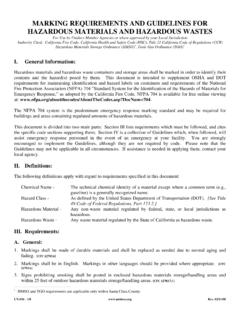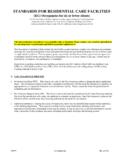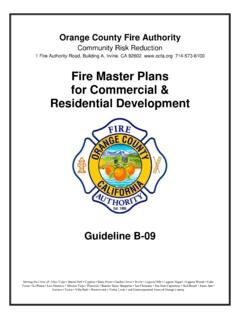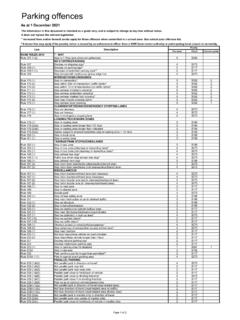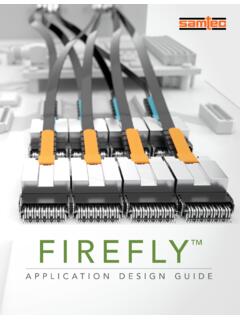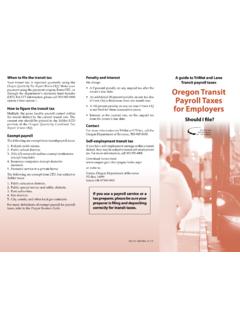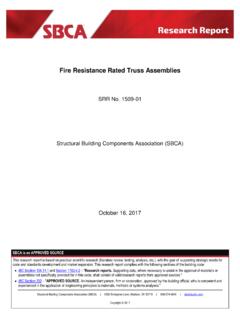Transcription of Standards for Fire Department Vehicle Access - Unidocs
1 UN-096 10/06/09 Standards FOR fire Department Vehicle Access For Use By All Jurisdictions, Cities and County, Within the Limits of Santa Clara County. Authority Cited: California fire Code (CFC), California Vehicle Code (CVC) The following standard identifies the requirements for fire Department Vehicle Access . Where noted, contact the local fire agency for further information and approval. 1. Access and Loading.
2 Facilities, buildings, or portions of buildings hereafter constructed shall be accessible to fire Department apparatus by way of an approved fire apparatus Access road with an asphalt, concrete, or other approved driving surface capable of supporting the imposed load of fire apparatus weighing at least 75,000 pounds (34,050 kg) or as otherwise determined by the fire Code official. 2. Minimum Clear Width. The minimum clear width of fire Department Access roads shall be 20 feet (6,096 mm). This width may be increased based upon specific Department operations and/or apparatus. Alternate designs may be approved on a case-by-case basis.
3 Modifications to the configuration or width of a fire Access road, or additional Access road(s) may be required when the fire Code official determines that Access to the site or a portion thereof may become compromised due to emergency operations or nearby natural or manmade hazards ( , flood prone areas, railway crossings, bridge failures, hazardous material-related incidents, etc.). The width of secondary Access roads may be reduced to less than 20 feet (6,096 mm) provided that turnouts are installed adjacent to the roadway every 500 feet, with a minimum dimension of 10 feet (3,048 mm) wide and 40 feet (12,192 mm) long or as otherwise determined by the fire Code official.
4 3. Minimum Clear Height. Minimum vertical clearance over required vehicular Access roads and driveways shall be 13 6 (4,115 mm). 4. Grade. fire apparatus Access roads shall not exceed 10% in grade, unless approval is granted by the fire Code official prior to construction. 5. Turning Radius. The minimum turning radius shall be determined by the fire Code official. 6. Dead Ends. Dead-end fire apparatus Access roads in excess of 150 feet (45,720 mm) shall be provided with width and turnaround provisions as determined by the fire Code official. 7. Parking. When parking is permitted on streets, in both residential/commercial applications, it shall conform to the following: a.
5 Parking is permitted on both sides of the street with street widths of 36 feet (10,973 mm) or more. b. Parking is permitted on one side of the street with street widths of 28 to 35 feet (8,534 to 10,668 mm). c. No parking is permitted when street widths are less than 28 feet (8,534 mm). [Note: Rolled curbs can be part of the curb/sidewalk and used to increase the roadway width with approval from the fire Code official. Additional requirements may apply for buildings 30 feet (9,144 mm) in height or greater. See requirements under item 19 (Aerial fire Apparatus Access Roads).] Standards for fire Department Vehicle Access Page 2 of 4 UN-096 10/06/09 8.
6 Access to Hydrant. fire hydrants located on a public or private street, or on-site, shall have an unobstructed clearance of not less than 30 feet (9,144 mm), with 15 feet (4,572 mm) on either side of the hydrant in accordance with California Vehicle Code (CVC) 22514. Marking shall be per CVC 9. Bollards. Bollards, when used to limit Access to the roadway, shall be moveable or fold-over type. Lift-out or knocked down types are not allowed. Hydraulic type bollards are allowed under special conditions only. All bollards shall be approved by the fire Code official prior to installation.
7 10. Traffic Calming. Traffic calming devices and the design thereof shall be approved by the fire Code official prior to installation. 11. Alternate Paving Material. Alternative paving materials such as Grass Crete, turf block, or similar-type materials may be used for emergency Vehicle Access (EVA) under certain conditions. An Alternate Materials and Methods request in accordance with California fire Code Appendix Chapter 1, may be required. Check with your local fire Code official. The submittal shall include the design criteria based upon the imposed load of fire apparatus as identified in item 1 ( Access and Loading).
8 The EVA shall be: a. Marked, with the lane at the curb delineated with lights, bollards, paint, contrasting material, etc. b. Structurally sound to preclude movement or disbanding with soil movement. c. Field tested by the contractor in the presence of the fire Code official. Contact the local fire agency for specifications on testing. Testing may include driving the EVA by a weight-verified Vehicle . Prior to testing, the soil shall be soaked for three days in a row. d. Prior to final approval, the engineer of record (civil or soils engineer) shall certify the installation. 12. Gates. No gate may be installed across a required fire Department Access road or driveway without prior approval from the local fire agency.
9 A detailed plan shall be submitted for review and approval prior to commencing any work. a. Security gates equipped with electronic control devices shall have an approved fire Department override key switch, and shall allow operation of the gate during power outages. Forms for ordering fire Department approved key switches and padlocks can be obtained from the local fire agency. b. Manual locking mechanisms ( , padlocks) shall be approved by the fire Code official. c. All manually operated gates shall be designed to remain in the open position when left unattended. Activation of an approved key switch for an electronically controlled gate shall open the gate and cause it to remain in the open position until reset by emergency response personnel.
10 D. When open, gates shall not obstruct any portion of the required width of the driveway or Access road, shall be adequately supported to prevent dragging, and shall be operable by one person. Sliding gates shall slide parallel to the security fence. Swing-style gates shall open a full 90 degrees (minimum) and may swing in either direction. Contact your local fire agency for setback distance. e. Gate components shall be maintained in operable condition at all times and be replaced or repaired when defective. 13. Separation of Access Roads. Where two Access roads are required, they shall be placed a distance apart equal to not less than one half of the length of the maximum overall diagonal dimension of the property or area to be served, measured in a straight line between accesses ( , from centerline to centerline).

